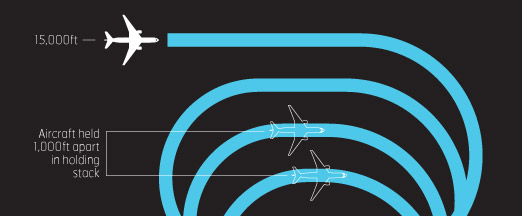Is this the end of stack holding?
20 May 2016Both The Times and Daily Mail have reported on the potential end of ‘stack holding’ over London in recent weeks.
For those that don’t know, holding stacks are the airport’s ‘waiting rooms’ for arriving aircraft. Whenever aircraft cannot proceed to land immediately, flights enter at the top of the stack – usually at around 11 or 12 thousand feet before gradually spiralling down to 7,000ft.
The NATS air traffic controllers in London Terminal Control at Swanwick and at airport towers around the country, then direct the aircraft onto the final approach path for the airport. The separation between arriving aircraft pairs is largely dependent on their size. A heavy A380, which whips up a lot of air turbulence in its wake, followed by the lighter B737 requires 7 miles separation, whereas the gap between two A380s is just 4 miles.
Choosing the optimum combination of arrivals is the key to making the most of the available runway capacity and at Heathrow, which is scheduled to 98% capacity, having a constant stream of arrivals allows optimum sequencing to take place and is absolutely vital to the smooth running of the operation.
It will be many years before aircraft can arrive at an airport ‘just in time’ so in the meantime we need to have a slight oversupply of aircraft to ensure that runway capacity is not wasted with unnecessary gaps. As such holding stacks are incredibly useful, but they are also noisy, inflexible and mean aircraft burn more fuel at lower levels and emit more CO2.
With the advent of more sophisticated satellite based navigation systems it’s now possible for aircraft to follow routes with an incredible level of accuracy. That means we’re able to be smarter about airport arrivals using a concept called Linear Holding.
There are two different types of linear hold, the trombone and the point merge. Both work by keeping all the arriving aircraft at the same level, but separated in the horizontal plane by satellite navigation tracks. At exactly the right moment – to the second – the aircraft is vectored off the linear hold and onto final approach. The big difference is that these linear holds can be much higher than a traditional stack, potentially up to 20,000 feet, and are therefore quieter for people living underneath and more fuel efficient for the airlines.
The traditional stack holds would remain for use in exceptional circumstances but they would be moved further out and raised up.
We’ve actually introduced one linear in the UK already; with the implementation of a point merge hold for arrivals into London City Airport. Instead of flying over land, arrivals now join the point merge arc out over the North Sea before being peeled off in the optimum order for a continuous decent approach into the airport.
The introduction of linear holds is just one example of the benefits of modernising the structure of UK airspace, much of which was designed in the 1950s and 60s. Air traffic is forecast to increase by 40% by 2030 and we need to act now if we’re going to keep pace with rising demand, while at the same time working to take advantage of the technologies that can help us minimise the impact of noise on the ground.
Comments
Please respect our commenting policy and guidelines when posting on this website.





20.05.2016
10:23
Tim
Can you confirm that this is the first time you have engaged with Heathrow communities on the use of tromboning for Heathrow arrivals ?
What are your plans to inform the Consultative Committee and Community Noise Forum ?
On what date did you implement the change / introduce revised procedures to use it ?
20.05.2016
14:06
Bengt Olson
Yepp. This will work once you learn to eliminate two things: weather and human pilots.
20.05.2016
15:32
Patrick
Is this new London City point merge the reason that block times for flights from Dublin to LCY have recently increased so appallingly?
20.05.2016
17:04
Tom Hiddleston
London City,all very well.When will we see this for Heathrow and Gatwick?
20.05.2016
23:28
Jason Whitaker
Would Linear Holds mean less aircraft noise?
27.05.2016
10:51
LesF
Linear hold techniques would be great if they work, but common sense says they can only work if you amend the flight schedules to bring aircraft into UK airspace at the same rate that they will land. Any other scenario results in the same queuing we have now. Is this blog a kiteflyer to kid us that stacking can be magicced away? The only way to eliminate queuing is to provide more runway space, and that can be done at Northolt. When you move all the small aircraft out of Heathrow to Northolt you don’t need a 7 mile gap behind an A380. The slots released at Heathrow can be filled up with large aircraft carrying more passengers in the current number of flights. Link the Heathrow and Uxbridge branches of the Piccadilly line so that all trains run round the loop and Heath-holt becomes effectively a single airport with three runways.
04.06.2016
20:06
Steve Balfour
So instead of having a holding structure that’s say 20nm x 10nm, you have one that covers several counties……..In some of the most congested airspace in Europe?
06.06.2016
12:33
Dave Curtis
Safety & Sustainability DirectorHi all,
Thanks for your comments. I’ll try to answer them in turn.
Tim – Tromboning hasn’t been implemented at Heathrow or anywhere else in the UK. If it were to be considered, it would of course be subject to the required consultations.
Bengt – point merge is aimed at being the core method of operation though it is recognised that controllers and pilots will always be needed to manage the exceptions.
Patrick – The point merge airspace changes did have some impact on the flights from the west particularly Dublin. NATS is working with the operators to find ways of minimising the impact while still delivering all the other environmental benefits that result from the new airspace.
Tom – A point merge system for Gatwick was suggested as part of LAMP1A, but Gatwick decided not to proceed with a consultation. However there is certainly an aspiration to eventually remove stack holding from both airports, but as I’ve said to Tim any change would require a public consultation so is some years away at the earliest.
Jason – yes that’s right. Linear holds can be much higher – up to 20,000 feet – meaning far fewer people would be subjected to noise.
I hope that helps.
Dave
12:33
Dave Curtis
Safety & Sustainability Director10.06.2016
10:54
Nick P
Dave Curtis, just thinking on here, if a ‘linear’ pattern works for reduction in noise for stacking alternative for arrivals, couldn’t a form of ‘linear spiral’ be used for aeroplanes to reach a desired height more quickly for departure as well?
11.06.2016
14:06
Graham
I appear to to live under the newly reruted route 4. The are trafic has recently got notisably heavy depending on West or eastly wind. I live on the a 23 Salfords. If the planes turned left 1 mile furthe on when the wind is from the west this would put the planes over a more commercial area ie east Surrey hospital and refuse sites waterworks. Why fly the planes over our hoses. We already put up with Redhill Airodrome and helepads, constant ambulance noise and a 23 trafic. Why not move the flight path slightly north .please.
25.10.2016
20:12
Damian
Presumably you could operate a linear stack at ~5000′ higher than the LCY stack for LHR, and simply have aircraft flying above the LCY traffic but on the same descent vector, achieving a huge benefit for LHR too?
How do you step from Westerlies to Easterlies on the fly though?
04.01.2017
10:10
Erik
Hi
I have recently moved to Rotherhithe which has both LCY’s westerly departures/easterly approaches plus the Heathrow flights coming in from the north-eastern stack. Needless to say it is very noisy.
Looking at an average day it looks very much like “tromboning” has already been implemented as flights go west over north London from the stack and then they turn south-east before they join final approach to LHR.
After reading about linear point merge I hope/assume that this would mean that LHR flights will point merge somewhere out over the Thames Estuary and then fly in a straight line all the way to LHR.
Can you please provide some more details about the proposed Point Merge setup for LHR? Where will the merge point on the east side of London be i.e for westerly landings?
Also any indication on timelines for implementation would be very helpful.
Thanks
29.01.2017
08:33
Richard
Please advise on when the new system for Heathrow will be implemented ? We live in Petts wood in Bromley and are subjected to a combination of easterlies every 1 min or the Biggin Stack all day long so there is never any peace. I never new this would exist so far from Heathrow but its extremely disturbing and starts very early some mornings and doesn’t stop until 11.30 pm
02.08.2019
15:57
Liam
Hi there Dave,
Thanks for the post, the info graphic is very insightful as to how air traffic works above the Heathrow airspace.
I made the assumption that all of the stack control is done by the approach controller? In the Netherlands stacks are actually set just outside the terminal area so that aircraft can be streamed into the terminal area.
I am a student in the Netherlands who is learning about holding stacks and I am learning quickly that delaying an aircraft’s arrival is done very differently outside of Heathrow. Stacks seem to be generally avoided as much as possible.
I am wondering about how an approach air-traffic controller decides upon which aircraft to take from the bottom of a holding pattern. Do they choose based on estimated time of arrival at the airport or based on position in the holding pattern? I’m guessing a combination of both?
Thanks,
Liam